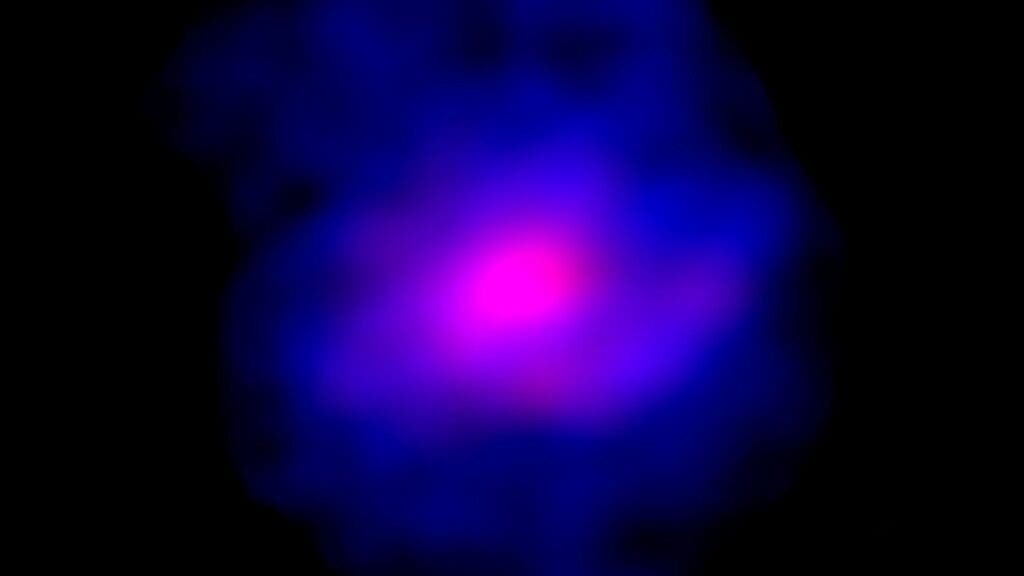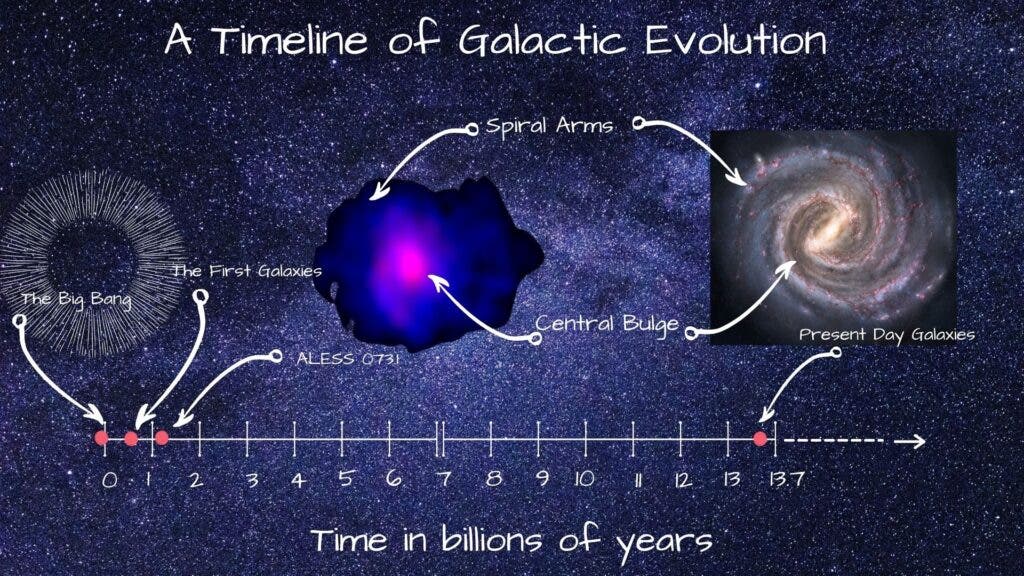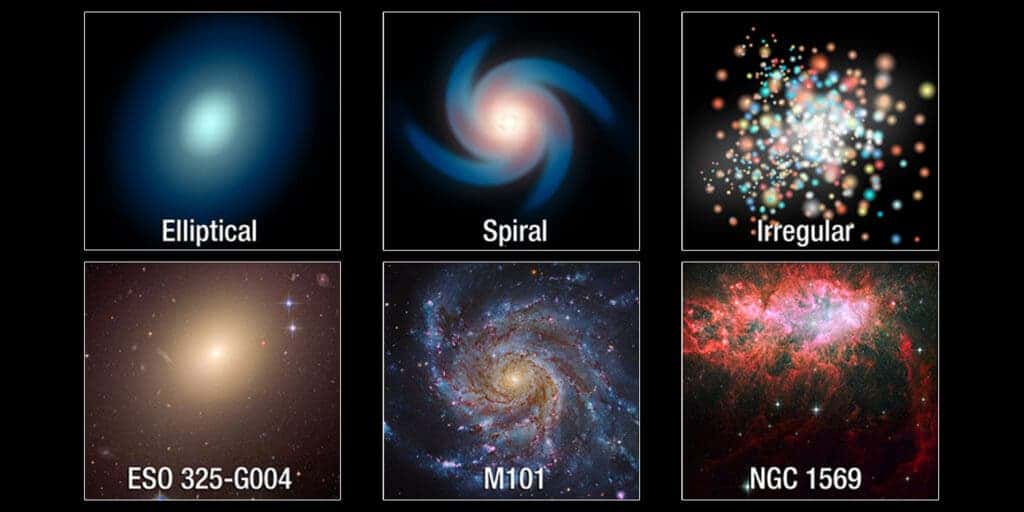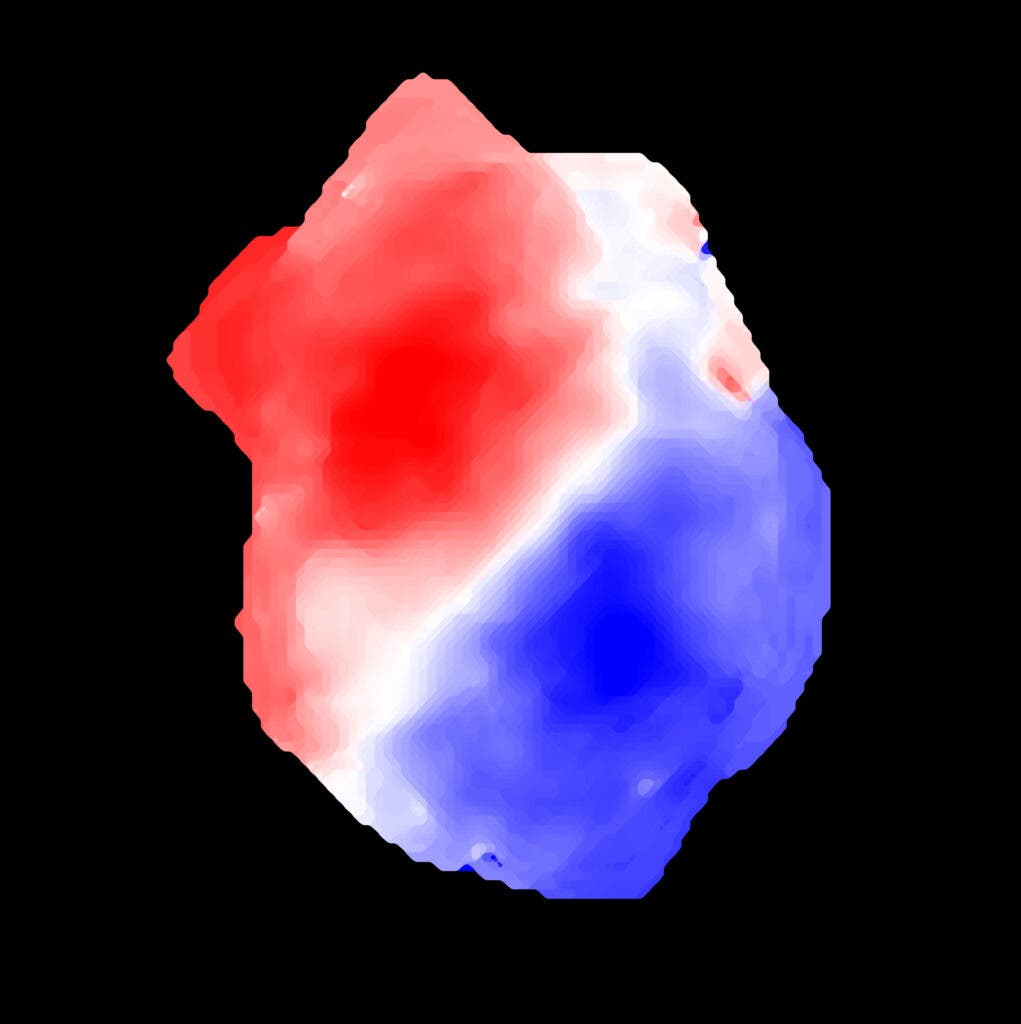A massive stellar bulge found in a regularly rotating galaxy when the Universe was just 1.2 billion years old could throw theories on galactic evolution into doubt. Current models of how galaxies form suggest that features like those spotted associated with the galaxy ALESS 073.1 should take longer to form and thus shouldn’t be visible when the Universe is so young.
“This galaxy is like a little child that looks like a full-grown adult,” Federico Lelli, an astrophysicist at Arcetri Astrophysical Observatory (INAF, Italy) and part of the team that identified the features, tells ZME Science. “This galaxy possesses three key features of ‘mature’ galaxies: a regular rotating disk, a massive bulge, and arm-like structures that are reminiscent of spiral arms.”

The team’s finding is discussed in a paper published in the latest edition of the journal Science and joins a series of other recent discoveries that suggest galaxies could evolve much quicker than currently believed.
The study is accompanied by a perspectives article by Julie Wadlow, Lancaster University, that reflects on the wider implications of the discovery of these features on our models of galactic evolution.
The team made their observations of ALESS 073.1 with the Atacama Large Millimeter/submillimeter Array (ALMA) based in the Atacama Desert Chile, currently the world’s largest radio telescope. It was emissions from the galaxy’s gas and dust that allowed the team to detect the motion of ALESS 073.1 and infer the presence of the bulge and spiral arms.
“Structures like bulges, regular disks, and possibly spiral arms must form in less than 1.2 billion years, which is a tall order for current models of galaxy formation,” says Lelli. “These properties imply that the formation of massive galaxies must be a fast process occurring very early in the history of the Universe.”

As Wardlow points out, this isn’t the first time ALESS 073.1 has caused some surprise in the field of astronomy since it was first glimpsed in 2009.
“The initial discovery of a galaxy forming stars so rapidly so far into the distant Universe was already a surprise and a challenge to the galaxy evolution models of the time,” she tells ZME Science. “Theorists are now able to explain the existent of a galaxy forming so many stars so early in the Universe, but this new detection of the bulge in ALESS 073.1 is unexpected.”
“It has implications both for the timescales of galaxy formation and evolution but also for the sorts of systems that can host massive bursts of star formation in the distant Universe.”
Structures That Challenge Galactic Evolution Models
The Universe is populated with billions of galaxies coming in a variety of different shapes — with the three main types being elliptical, spiral, and irregular.

Spiral galaxies, like our own Milky Way, are perhaps the galaxy shapes that we are most familiar with. These are typified by a central nucleus with spiral arms extending from this central region. Whilst most galaxies are expected to go through a special phase, structures like spiral arms and central bulges should take longer to form according to current models, so we shouldn’t be seeing them in the early Universe. That means spotting them in ALESS 073.1 is extremely surprising.
“Galaxies forming in the primordial Universe are expected to be chaotic and turbulent because they are accreting gas from the cosmic web, they are forming stars at very high rates leading to many supernovae explosions, and they have central supermassive black holes growing in mass and shining as active galactic nuclei,” says Lelli. “All these mechanisms are expected to inject large amounts of energy into the gas and heavily perturb its overall kinematics.
“The regularity of the gas disk in ALESS 073.1 is at odds with these expectations.”
The team of astronomers decided to study ALESS 073.1 because previous observations with ALMA in 2014 had indicated the presence of a rotating disc, but the data wasn’t precise enough to properly distinguish this from other possible explanations.
“The galaxy is forming stars at an incredibly high rate — about 1000 solar masses per year — and has a central supermassive black hole emitting in the X-rays, so some authors argued in favour of a gas outflow rather than a regular rotating disk,” Lelli says. “The new data unambiguously shows that the galaxy has a very regular rotating disk.”
ALESS 073.1’s central bulge of closely clustered stars is also a feature that would usually be associated with a more mature galaxy. “Bulges are expected to form either by the merging of two disk galaxies of similar mass or by slow internal processes within the rotating disk,” says Lelli. “Both mechanisms take time to form a massive bulge, so we were really surprised to find that nearly half of the stars in ALESS 073.1 are in a bulge component.”
The Wider Implications of ALESS 073.1’s Mature Features
In the associated perspectives piece accompanying Lelli and his coauthor’s study, Wardlow points out that current theoretical simulations suggest these early or primordial galaxies merge together through gravitational interactions forming large, chaotic structures. These may have some rotation and eventually form central bulges comprised of older, redder stars.
“Discs take time to form as the motion of the stars and gas in the first galaxies slowly becomes dominated by gravity rather than the initial forces from formation,” Wardlow explains. “Bulges are found in the centres of disks and are expected to form even later and after an event which gravitationally disturbs a galaxy. This disturbance alters the motion of the stars and gas, such that they become irregular, but still bound the galaxy.”
Wardlow goes on to explain that this disturbance could be something external — like a collision or close encounter with another galaxy — or something internal — like a runaway gravitational instability in the galaxy.

The problem is, these mechanisms put tight time constraints to the evolution of galactic features because they require some structure is already present in the galaxy. “They both require significant galaxy structure with rotation to have already formed, and then time for the triggering event to have happened and for the dynamics of the system to have calmed into the disc and bulge that is seen in ALESS 073.1 ~1.2 billion years after the Big Bang,” Wardlow explains. “In the merger/interaction scenario it also requires a second galaxy to already be in place at the time of the merger/interaction.
“So the presence of these features in ALESS 073.1 means that the timescales for early galaxy formation and evolution must be short, which provides a challenge for models and simulations if systems like ALESS 073.1 are common.”
This gives a good hint at what the next step for Lilli and his team could be, searching for other young galaxies shortly after the Big Bang with similar mature features. That’s the aim of a project underway at ALMA called Tracing Rotation with Ionized Carbon in Early Primeval Systems (TRICEPS).
“Observing more galaxies at similar distances with ALMA will allow us to statistically establish how common rotating gas disks are in the early Universe. We are already working along this path,” says Lelli. “The observations were supposed to take place last year, but unfortunately the ALMA observatory was shut down due to the Covid-19 emergency. A lot of good people — not only astronomers but also engineers, mechanics, technicians, cooks, cleaners and the like — are working at the Atacama desert in Chile to make these observations possible. So it’s complicated to go ‘back to normal’ after a global shutdown.
“I really hope I could have some new ALMA data on my laptop by the end of 2021.”
Beyond the TRICEPS project, Lelli also points out that both the James Webb Space Telescope (JWST) — set to launch later this year — and the Extremely Large Telescope (ELT) — currently under construction in the Atacama Desert — could allow astronomers to observe primordial galaxies at different wavelengths. Crucially, this will allow them to directly study the light emitted by their stellar components. “This may allow us to time more precisely the first epoch of galaxy formation.”
Wardlow adds that because light doesn’t travel infinitely fast, when astronomers look at distant galaxies they are seeing them as they were in the past, often billions of years ago as is the case with ALESS 073.1. “So the light that’s been detected from ALESS 073.1 started its journey 12.5 billion years ago,” She concludes. “By now ALESS 073.1 will be even more evolved and probably bears very little resemblance to what we’ve detected.
“By observing distant galaxies it’s like we’re time-travelling back to near the beginning of the Universe to solve the mysteries of how everything in our lives came to be.”
Sources
Lelli. F., Di Teodoro. E. M., Fraternali. F., et al, ‘A Massive Stellar Bulge in a Regularly Rotating Galaxy 1.2 Billion Years After the Big Bang,’ Science,[2021],[https://science.sciencemag.org/cgi/doi/10.1126/science.abc1893]
Wardlow. J., ‘Speedy galaxy evolution,’ Science, [2021], [https://science.sciencemag.org/cgi/doi/10.1126/science.abg2907]






